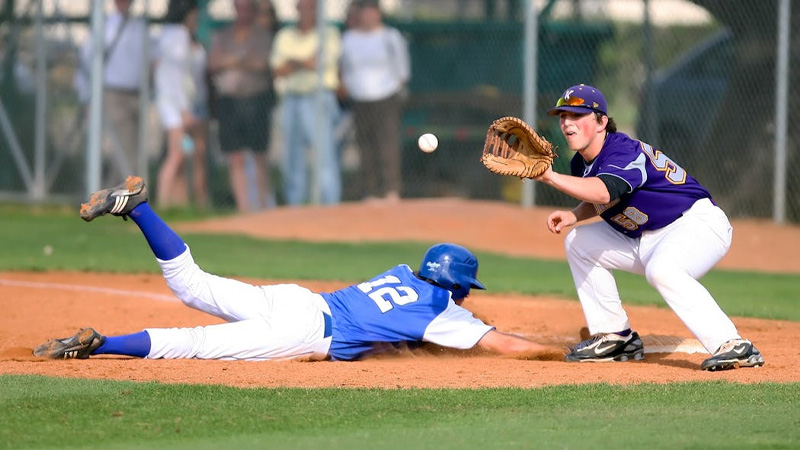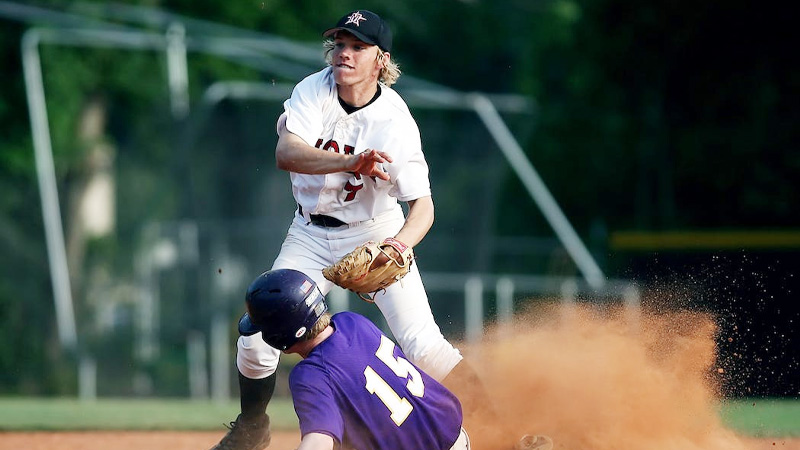In the game of baseball, certain plays can drastically shift the momentum of a match, and one such play is the “ground into double play” (GIDP).
This term refers to a situation that unfolds when a batter hits a ground ball to an infielder, who skillfully initiates a double play by swiftly transferring the ball to another infielder.
The result is two outs recorded in a single play, leaving the batting team frustrated and the defense jubilant.
Let’s explore the intricacies of the ground in a double play in baseball, exploring its mechanics, implications, and significance within the context of the game.
What Is Ground Into Double Play (GIDP)?
An example of a “ground into double play” (GIDP) occurs when a batter hits a ground ball to an infielder, who then initiates a double play by throwing the ball to another infielder.
The second infielder steps on second base to force out the first-base runner and then throws to first base to retire the batter. A double play means that the defense turns two outs from a single batter when a batter grounds into it.
Taking advantage of this opportunity eliminates the batting team’s chance to rally and score. 6-4-3 or 4-6-3 indicates that the batter got out at the second base, first base, and second base again on a double play.
There are various situations where runners can ground into double plays, such as when runners are on both first base and second base. The defensive team must field the ball quickly and execute efficiently to turn the double play.
A player with the most GIDPs is one who hits ground balls frequently while running slower than other players in Major League Baseball (MLB).
Players with high slugging power may also rack up an increased number of home runs as a result, as they are known for better slugging than speed.
What Does GIDP Mean In Baseball Stats?
A GIDP refers to a ground-into-double play on a baseball scorecard. As a result, there were two outs when the batter hit a ground ball that a defensive player fielded. Baseball allows ground balls to be turned into triple plays occasionally, but they are very rare.
Players with a high number of GIDPs could hurt their team’s offensive performance. This does not necessarily mean the player is not proficient as a hitter or does not bring value to the team.
On the list of all-time career ground-into-double-play leaders are also some of the top home run hitters, which includes many Baseball Hall of Fame members.
What Is GIDPO?

This acronym stands for grounded into double play opportunities. A batter’s ground ball success rate is measured by the number of options to get a double play, while GIDP measures the proportion of those double plays actually completed.
Ground balls can be used in GIDPOs when hit with at least one baserunner and fewer than two outs.
How Many GIDPs Are In A Baseball Game?
Many double plays occur in general. For example, a team had an average of 145 double plays per 162 games during MLB’s 2016 regular season. However, it is important to note that not all of these double plays were GIDPs.
May 4, 1969, was the date when the San Francisco Giants accumulated seven GIDPs in a single game and ultimately lost 3-1 to the Houston Astros.
How Are GIDPs Used To Evaluate Pitchers?
There is no pitcher associated with GIDPs; they are attributed to the batter. In addition, pitchers may be rated based on the number of times they forced a batter to hit a ground ball into a double play.
Grounding into double plays is influenced by the pitcher’s choice of pitch and how efficiently they execute that pitch. Because GIDPs provide defenses with two outs quickly, pitchers who can induce a ground into double play are invaluable.
How Is GIDP Recorded?
An official scorer must record the Ground Into Double Play (GIDP), which is a neutral observer sitting in the press box during a game and capturing all of the important field events.
Scorers accurately record hits into double plays and assigns them to players. It is essential for an official scorer to determine that the batter hit the ball on the ground and that two outs were recorded on the same play before he or she can record a GIDP.
Once this is established, the scorer assigns the GIDP to the batter who struck the ball. The play is also credited with retiring any runners on base that were on base at the time.
What Are The Odds Of Getting A GIDP?
Several factors can influence whether ground into double play occurs, such as how many plate appearances a player records, how often runners are on base during a player’s at-bat, the pitcher’s skills, and the defense’s reaction time. The chances of receiving a GIDP cannot be predicted because so many factors are involved.
How Many Types Of Double Plays Are There?
In baseball, double plays are categorized by their corresponding numbers corresponding to each defensive player:
- Pitcher
- Catcher
- First baseman
- Second baseman
- Third baseman
- Shortstop
- Left fielder
- Centre fielder
- Right fielder
The scorekeeper keeps track of which defensive positions contributed to the double play and in what order.
An example might be a 4-6-3 double play, in which the second baseman (4) fields the ball before throwing it to the shortstop (6) to get the first out at the second base, followed by a throw to the first baseman (3) for the second out.
Defining a double play using any three numbers from 1 to 9 is theoretically possible. Double play may occur in many different ways, but certain types happen more frequently.
- 3-6-1 Double Play
- 1-2-3 Double Play
- 6-4-3 Double Play
- 3-6-3 Double Play
- 4-6-3 Double Play
The objective of a GIDP is to move the ball from one player to another. This is usually achieved with three players on the field, but there are times when two players are involved.
The first baseman could, for instance, tag first base for the first out, then throw the ball to the shortstop to get the second out at second base. A double play of 3-6 would be recorded here.
Several players can complete a double play at once. An infielder usually catches a line drive in these situations, which results in an automatic out for the batter. As soon as the runner is tagged out, they tag him at a base before he can return home.
If both runners are on first base, the first baseman could catch a line drive and tag first to eliminate both batters.
It is called an unassisted double play when one player completes the double play without assistance. The chance of an unassisted double play changing into a GIDP is extremely low.
It is rare to see a double play in which a strikeout is immediately followed by an out for a baserunner caught stealing. As the batter does not complete a hit, this would not qualify as a GIDP.
Most commonly, in these scenarios, a pitcher strikes out the batter, followed by a catcher throwing the ball to a fielder (usually a second baseman or shortstop).
Do You Get An RBI For GIDP?
The run batted in (RBI) award is given to a batter when a run is scored during their plate appearances. When a ground game into double play results in a teammate scoring a run, the batter is not credited with an RBI.
Who Has The Most MLB Record For Grounding Into Double Plays?
Hank Aaron, a hall of fame and the top GIDP player in MLB history hit 328 double plays throughout his career. Despite being regarded as a legendary player, Aaron had a high number of GIDPs, indicating how difficult it is to avoid making outs that hurt a team’s offensive achievement.
What Is The Rarest Double Play In Baseball?
In baseball, the 3-2-8 double play is considered the most rare. It is achieved when the first baseman (3) fields the ball and throws it to the catcher (2), who gets the first out. To get the second out, the catcher throws the ball to the centerfielder (8).
Against the Cleveland Indians on August 28, 2020, the St. Louis Cardinals completed a 3-2-8 double play. It was the first time this type of double play had been achieved in the expansion era of the MLB, which began in 1961.
What Is The Most Common GIDP?
The majority of GIDPs occur after two force outs, so the defense needs only to touch the bags to make the outs rather than tag the players directly. Double plays of this type are famous, such as the 6-4-3 double play.
Double plays of this type consist of the shortstop (6) fielding the ball before throwing it to the second baseman (4) for the first out and the first baseman (3) for the next out. Baseball fans sometimes abbreviate the number 6+4+3=2 since this series of events often results in two outs.
How Many Outs Result From A Player Grounding Into A Double Play?
Whenever a player grounds into a double play, two outs are recorded. It can change the momentum of a game dramatically, as the offensive team loses a potential scoring opportunity and the defense gains valuable opportunities.
Final Words
Ground Into Double Play (GIDP) in baseball measures a batter’s ability not to make outs detrimental to his team’s offensive performance. Whether you are a player, coach, or baseball enthusiast, understanding the GIDP is essential.
As a result of paying attention to these statistics, coaches, and players can improve their offensive performance and reduce their chance of experiencing double plays.
It makes it easier for fans to evaluate player performance and to understand how defensive strategies impact the game by understanding the GIDP.







